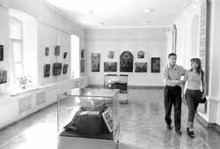For several years Ukrainian museums, the treasuries of our nation’s history and culture, have been languishing in a state of dreams that did not come true. Gone are the times when museum curators did not need to worry about their daily bread and relied when need be on financial and organizational support from the state. The powerful wave of copying Europe has also swept over this sphere, putting our museum personnel in new tougher conditions. The state is now allocating to museums 50% at most of what they require. The cash-strapped museums are forced to resort to fundraising or look for help to sponsors, art patrons, and other art aficionados ready to financially support special foundations established at museums and galleries. Incidentally, this is an absolutely normal practice in most European countries. For example, even the Louvre, the national pride of France, has but limited access to the state treasury.
In general, everything is as it should be. The only problem is that Ukrainian museum business operators (is it really a business?) are totally unprepared for such tempestuous professional activity. The knowledge and skills they once acquired in university museum courses are obviously inadequate for successful work today. In a word, museum personnel as a whole needs to upgrade their professional skills. Ukrainian museum employees have to solve this and other problems on their own.
Yet, there is every reason to believe that the renascence of Ukrainian museums is approaching. The first major step toward the European development of the museum business was taken as long as a year ago by the National Fine Arts Museum of Ukraine: the latter began to implement Ideal Museum, a program for Ukraine’s museum personnel to upgrade their professional skills. Always considered sort of a resource center attracting museum people from all over Ukraine, the National Museum of Fine Arts has again become a source of new knowledge. According to Tetiana Hrushchenko, information chief of the National Fine Arts Museum and initiator of the Ideal Museum project, a whole series of workshops has already been held, as part of the project, on museum marketing and fundraising, as well as a course in effective museum management and museum-related pedagogy. The training courses were conducted by outstanding Chicago and Ludwigsburg Universities professors and the leading research fellows of Russian museums. The latter, incidentally, also passed their own turning point of the museum business with the help of Western colleagues. It is worth noting that one of the latest Karl Briullov exhibitions brought the Moscow Tretiakov Gallery $3 million?
“In the not so distant future,” Ms. Hrushchenko said, “the Ukrainian museum employees training program will hold a number of seminars and round tables on museum law, the legal and esthetic expert examination of art works, and state-of-the-art museum technologies, including online museums in the Internet.”
However, it would be wrong to say that the supply of professional personnel alone, without governmental material support, will be sufficient for the development of the museum business in this country. At least all matters concerning museum territories and structures are still under the jurisdiction of public administration bodies. The shortage of exhibition area is one of the gravest problems for Ukraine’s museums and galleries: having unique collections of exhibits, they are absolutely deprived of an opportunity to display these to the public due to absence of specially-equipped premises. This problem was discussed recently at a regular meeting of Kyiv museum directors and chief curators, Ministry of Culture and the Arts experts, and foreign museum business specialists, called The Problems of Construction and Technical Equipment of Museums. The employees of Ukrainian museums were heeding with envy and hope the words of the manager of a German museum equipment company, Harold Rothstein, who described the advantages of his firm’s products. Mr. Rothstein said he intended to win a tender to install his equipment in some Kyiv museums, with the National Fine Arts Museum being first in line. Dust and vapor penetration as well as bulletproof exhibition windows with automatic temperature regulation and air purification is, of course, not a very cheap pleasure, but to opt for something cheaper here would in fact mean to destroy the things on which the historical landmarks of a great nation rest.







